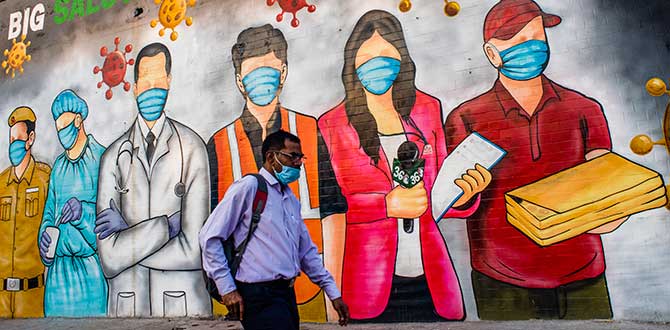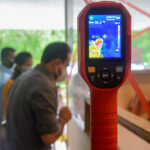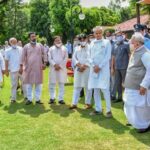‘The lockdown was for both: To flatten the curve or more correctly, delay the rapid spread of COVID outbreak, and to create healthcare infrastructure.’
Photograph: Yawar Nazir/Getty Images
Dr Raman Gangakhedkar, former deputy director, Indian Council of Medical Research and the face of the central government’s medical team combating coronavirus retired on June 30.
Te soft-spoken doctor will continue his association with ICMR as the Dr C G Pandit National Chair in Pune.
The narrative of India’s mammoth efforts to combat the pandemic and its medical management will be difficult to write without the ICMR’s top brass’s real-time experiences.
Dr Gangakhedkar was a member of ICMR’s crisis management team.
In a candid interview with Senior KhabriBaba.com Contributor Sheela Bhatt, soon after retirement, Dr Gangakhedekar — who is in self-quarantine after traveling from Delhi to Pune — eloquently defends the measures taken to deal with the COVID-19 crisis.
IMAGE: A medic collects a swab sample of a woman who came to attend a wedding in Bhadwasiya, Jodhpur, July 9, 2020. Photograph: PTI Photo
What are the peculiar characteristics of coronavirus that you now find after five months of rich experience?
In January-February we knew corona was transmissible.
Then, we had access only to videos from China, not many scientific publications on hand. We also saw how things are happening in China, but then we didn’t know the intensity of the virus, that it is so highly transmissible.
There were some videos in which people were shown walking on the road and falling down.
Then, we had no clue what is going on, which infectious disease we were dealing with. So there was a scare.
Some videos may be fake videos, but they created a scare in scientists and lay persons as much.
I distinctly remember that in China they used almost military type steps to ensure that everybody comes to the hospital, people were locked in their houses. They felt that citizens’s rights become secondary…
Another dramatic thing which we couldn’t understand over a period of time was that without having any drug or any preventive vaccine suddenly they declared Wuhan clear of covid.
There were other provinces which had seeds of infection, but that news also disappeared very quickly.
So, we didn’t have much clue as to what was really happening in China — what works and what does not.
Perhaps lockdown works the best…
But the moment it went to Iran, some Indians got infected as they went on pilgrimage. We knew what was going on, how the virus impacts and when.
In Italy, we saw the fear of high transmissibility as a reality unknown hitherto.
But now, over a period of time, we have more clarity about this particular disease.
We implemented non-pharmacologic interventions after the first paper came around in Lancet in February only, I think.
Until then we didn’t know as much about China’s non-pharmacologic interventions that they had tried and its impact.
IMAGE: A health worker scans the temperature of an elderly lady in Dharavi, Mumbai’s largest slum, July 9, 2020. Photograph: Kunal Patil/PTI
But during the lockdown we managed to get so much of time, we could ensure a few things.
It was scary to begin with when you heard that China had built a 1,500-bed hospital in a week’s time. But it also conveyed to us that we would require many beds to hospitalise our people.
The only way out was to go for s lockdown and try to ensure that we would have sufficient beds available for people.
We knew that most covid patients were going on the ventilator at that time in China so we needed to augment our capacity of intensive care units for providing the right kind of critical care through trained physicians at every level of health care — tertiary, secondary, primary…
IMAGE: A health worker collects a swab sample at Ultadanga in Kolkata, July 9, 2020. Photograph: ANI Photo
We heard that China had undertaken a huge number of drug trials so our expectations were high.
By February end, the numbers of patients were pretty high in China so we thought all their clinical trials would be over, but that didn’t happen.
Actually, most of their trials started sometime around March end and some in April. I think they were also swamped, their scientists were doing multi-tasking — managing patients as well as doing different kinds of research, therefore they didn’t have opportunity.
What was more surprising for us was that China didn’t have a large number of participants enrolled in those studies as well as trials.
Unfortunately, in their clinical trials, the number of participants is close to about 300 to 400 maximum.
Initially, when the observational studies came, there were hardly 60 to 100 patients enrolled in those studies.
The infection had come almost a month later in India. We detected the first case at the end of January. We took some time for isolation of the virus.
And we were almost behind by one-and-a-half months…
IMAGE: A medic shows a rapid test kit for COVID-19 at a testing centre at a government school in New Delhi. Photograph: Kamal Kishore/PTI Photo
This time gap impacted development of different tools because unless you have a virus, you know less enough about the virus.
Unless you know the genetic structure of the virus, you cannot think in terms of developing your own indigenous diagnostic kits.
Once we isolated the virus, then the rest is a story!
Because you know, we had to depend either on China or some other parts where they developed diagnostic kits as they had the virus as well as the sequence. Everybody in the world was chasing the same diagnostics kits, it was a harassing experience.
It was like we were trying to do something and there were no dependable diagnostic kits available.
I remember those troublesome days.
IMAGE: A medical health worker holds a test sample at a school which was turned into a centre to conduct tests for the coronavirus in New Delhi. Photograph: Anushree Fadnavis/Reuters
But China had it. Wuhan was solved by March.
No. China continued to have a high requirement of the diagnostic kits. Getting them in India was tough.
Their distributors used to agree to provide kits, but when it came to delivery they used to request an extension.
Every week they would come and tell us, ‘Oh, I can’t deliver it now. There are too many orders.’
It took almost 2 to 3 weeks. I am not the right person to tell you about these delays because it was being dealt by somebody else.
It was frustrating that they would provide us a few thousands and keep promising future dates.
And we at ICMR could not speak about it in public because people would get demoralised.
But I think in a way, the lockdown provided us an opportunity to scale up the testing sites, we could provide enhanced access to people.
Though I keep saying that it was difficult to obtain kits, kits was never an actual constraint because we managed it in a effective manner.
At no point in time, was our capacity to test ever utilised completely and it remains so even today.
We could scale up the operations as planned.
Where was the command and control structure of covid management?
How did it function?
Perhaps, that is one thing you should ask when the corona pandemic ends because then it will make a better cohesive story.
IMAGE: The testing facility at the National Institute of Virology, Pune. Photograph: Kind courtesy niv.co.in
So which were the institutions doing things really fast?
Isolation of the virus was done by ICMR-National Institute of Virology.
That was the only capable institution because they had a BSL4 facility. It requires as certain bio-safety level.
When you know that this could be a high risk pathogen you need BSL4 or at least a BSL3 facility.
Since these people were good at isolation, we thought the only place where we can do it should be in NIV, Pune.
Coronaviruses are difficult to isolate.
ICMR-National Institute of Epidemiology, Chennai, ICMR NIV’s Allapuzha unit, ICMR-National AIDS Research Institute, Pune, ICMR-National Institute for Malaria Research, New Delhi, ICMR-Regional Medical Research, Bhubaneswar, ICMR-National Institute for Cholera & Enteric Diseases, Kolkata, ICMR-National Institute for Research in Reproductive Health, Mumbai played an important role in addition to all other ICMR institutions extending COVID-19 testing.
And what about ICMR’s various guidelines?
Who were the people who gave you inputs?
The reality is that it was a tough time.
When people can’t come to the institutes because of the lockdown, there was no public transport for them to take them to the institute.
One of the things we did was we picked up talent pooled from different institutions and make them work at the headquarters in Delhi.
India has the brains, we have the capacity, but this was an unusual situation.
It was the DG’s idea to bring scientists from institutions. That worked well…
If everything is normal, you can pool all your resources, but when it is lockdown, you know, it becomes very tough.
And it is something that we must remember that, the scare was as high everywhere.
It is not that if you are a scientist you will not have a scare of acquiring this infection.
IMAGE: A patient and her relatives interact via a video calling facility provided by the Lok Nayak Jayaprakash Narayan Hospital in New Delhi, July 9, 2020. Photograph: Prateek Kuma/ANI Photo
Was the lockdown necessary to flatten the curve? Or was it to help the government to build up healthcare infrastructure and logistics?
When you look back, do you regret your advice to the government?
No, I don’t regret the lockdown.
Even for the sake of science we needed it.
Science is also in waves of actions that were taken together.
Look at the lockdown as an approach.
The entire world went into lockdown.
Every country at one or the other time went into lockdown because we were given to a type of thinking after seeing reports from China.
When China opted for a lockdown, they could almost stop the spread of infection.
There was a term — ‘flattening the curve’ — which appeared very appealing at that point of time.
At the same time, there was another model that claimed the lockdown is an opportunity to ensure that your healthcare infrastructure is in place.
Soon after lifting the lockdown, the number of cases would increase, so you should have hospital facilities.
Lockdown cannot be a long-term measure. Once you lift it, you must have risk mitigation in place.
So, the lockdown was for both: To flatten the curve or more correctly, delay the rapid spread of COVID outbreak, and to create healthcare infrastructure.
Feature Production: Ashish Narsale/KhabriBaba.com




